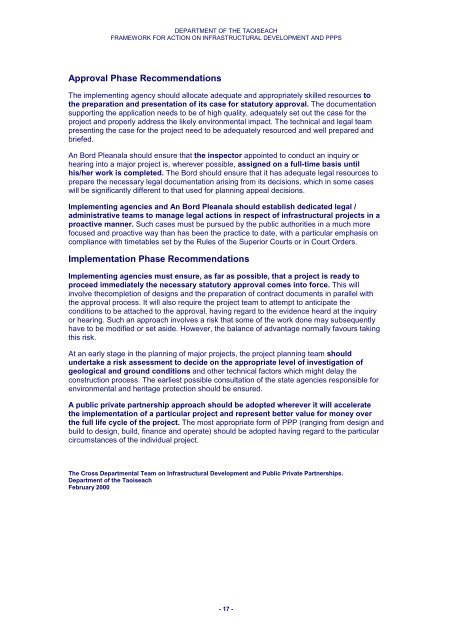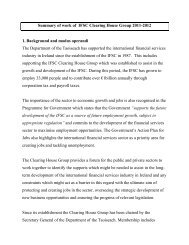Framework for Action on - Department of Taoiseach
Framework for Action on - Department of Taoiseach
Framework for Action on - Department of Taoiseach
Create successful ePaper yourself
Turn your PDF publications into a flip-book with our unique Google optimized e-Paper software.
DEPARTMENT OF THE TAOISEACH<br />
FRAMEWORK FOR ACTION ON INFRASTRUCTURAL DEVELOPMENT AND PPPS<br />
Approval Phase Recommendati<strong>on</strong>s<br />
The implementing agency should allocate adequate and appropriately skilled resources to<br />
the preparati<strong>on</strong> and presentati<strong>on</strong> <strong>of</strong> its case <str<strong>on</strong>g>for</str<strong>on</strong>g> statutory approval. The documentati<strong>on</strong><br />
supporting the applicati<strong>on</strong> needs to be <strong>of</strong> high quality, adequately set out the case <str<strong>on</strong>g>for</str<strong>on</strong>g> the<br />
project and properly address the likely envir<strong>on</strong>mental impact. The technical and legal team<br />
presenting the case <str<strong>on</strong>g>for</str<strong>on</strong>g> the project need to be adequately resourced and well prepared and<br />
briefed.<br />
An Bord Pleanala should ensure that the inspector appointed to c<strong>on</strong>duct an inquiry or<br />
hearing into a major project is, wherever possible, assigned <strong>on</strong> a full-time basis until<br />
his/her work is completed. The Bord should ensure that it has adequate legal resources to<br />
prepare the necessary legal documentati<strong>on</strong> arising from its decisi<strong>on</strong>s, which in some cases<br />
will be significantly different to that used <str<strong>on</strong>g>for</str<strong>on</strong>g> planning appeal decisi<strong>on</strong>s.<br />
Implementing agencies and An Bord Pleanala should establish dedicated legal /<br />
administrative teams to manage legal acti<strong>on</strong>s in respect <strong>of</strong> infrastructural projects in a<br />
proactive manner. Such cases must be pursued by the public authorities in a much more<br />
focused and proactive way than has been the practice to date, with a particular emphasis <strong>on</strong><br />
compliance with timetables set by the Rules <strong>of</strong> the Superior Courts or in Court Orders.<br />
Implementati<strong>on</strong> Phase Recommendati<strong>on</strong>s<br />
Implementing agencies must ensure, as far as possible, that a project is ready to<br />
proceed immediately the necessary statutory approval comes into <str<strong>on</strong>g>for</str<strong>on</strong>g>ce. This will<br />
involve thecompleti<strong>on</strong> <strong>of</strong> designs and the preparati<strong>on</strong> <strong>of</strong> c<strong>on</strong>tract documents in parallel with<br />
the approval process. It will also require the project team to attempt to anticipate the<br />
c<strong>on</strong>diti<strong>on</strong>s to be attached to the approval, having regard to the evidence heard at the inquiry<br />
or hearing. Such an approach involves a risk that some <strong>of</strong> the work d<strong>on</strong>e may subsequently<br />
have to be modified or set aside. However, the balance <strong>of</strong> advantage normally favours taking<br />
this risk.<br />
At an early stage in the planning <strong>of</strong> major projects, the project planning team should<br />
undertake a risk assessment to decide <strong>on</strong> the appropriate level <strong>of</strong> investigati<strong>on</strong> <strong>of</strong><br />
geological and ground c<strong>on</strong>diti<strong>on</strong>s and other technical factors which might delay the<br />
c<strong>on</strong>structi<strong>on</strong> process. The earliest possible c<strong>on</strong>sultati<strong>on</strong> <strong>of</strong> the state agencies resp<strong>on</strong>sible <str<strong>on</strong>g>for</str<strong>on</strong>g><br />
envir<strong>on</strong>mental and heritage protecti<strong>on</strong> should be ensured.<br />
A public private partnership approach should be adopted wherever it will accelerate<br />
the implementati<strong>on</strong> <strong>of</strong> a particular project and represent better value <str<strong>on</strong>g>for</str<strong>on</strong>g> m<strong>on</strong>ey over<br />
the full life cycle <strong>of</strong> the project. The most appropriate <str<strong>on</strong>g>for</str<strong>on</strong>g>m <strong>of</strong> PPP (ranging from design and<br />
build to design, build, finance and operate) should be adopted having regard to the particular<br />
circumstances <strong>of</strong> the individual project.<br />
The Cross <strong>Department</strong>al Team <strong>on</strong> Infrastructural Development and Public Private Partnerships.<br />
<strong>Department</strong> <strong>of</strong> the <strong>Taoiseach</strong><br />
February 2000<br />
- 17 -
















